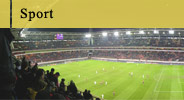Iran might seem to be a very different place to Ireland, but as Gearóid Ó Cólmáin discovers, some things are very similar indeed...
I’ve just returned from three wonderful weeks in the Islamic Republic of Iran. And for any Irish travellers seeking to explore that extraordinary country, I have one word of advice: tarof.
The word tarof in Farsi roughly corresponds to politeness in English, but its application involves scrupulous discretion. The Iranians are without question among the most civilised people in the world, and the concept of tarof is an indispensable aspect of daily life in Iran.
For Irish people, tarof should not pose insuperable problems. Indeed we Irish, although in a typically informal way, have our own form of the custom. I recall countless occasions in the past when my parents were visited by our neighbours. When my mother would offer tea, they would routinely refuse.
“Will you have a cup of tea?” my mother would ask.
“No, I’m grand, I’m just after having one,” our neighbours would respond.
“Ah go on, have a cup of tea,”
“No, no, I’m grand, don’t bother; really I’m fine, I just had five cups of tea before I left.”
“Ah go on, have one cup, go on, ‘tis just made an all. Sit down and have a cup of tea for God’s sake. Go on, sit down!”
“Oh go on so. I’ll have one cup,”
The Iranian custom of tarof functions in a similar way. When offered something you must refuse, even when you would like to accept it. In general, two refusals will be followed by a third offer designed to break your polite resistance. It is then polite to accept the offer, be it a cup of tea or an invitation to dinner.
The Irish hold the distinction of being the friendliest people in Europe. There might be some truth in this, but if there were a competition to determine the friendliest people on the planet, our cousins in the Middle East would lap us 10 times over.
And cousins we may very well be. According to some Indo-European scholars, there is the possibility that Éireann and Iran are cognate, both being derived from the Aryan tribe. There are, however, many proposed etymologies of the word for Ireland and it remains an open question among the experts. But there are certainly striking parallels between Irish and Persian mythology, attesting common Indo-European origins.
The Persian language, although heavily coated with Arabic words since the Islamic invasion of 640 AD, is nevertheless fundamentally Indo-European – and Persian, or Farsi, bears many curious and sometimes puzzling similarities to European languages. One word which struck me as I was learning the language was the word for woman. In Farsi it is ‘banu’. Could this be a cousin of the Irish ‘bean’?
Speaking of women, young Iranian girls are – in spite of their hijab – exceedingly elegant. Their long coats are often worn as tightly as possible and the hijab only serves to accentuate the Parisian cosmetics, jewellery and ravishing hair exposed from the crown to the forehead.
But the cult of beauty is not only confined to Iranian women: with their manga haircuts, Italian jeans and t-shirts, Iranian lads are among the coolest dudes in the world of fashion.
One of the differences between Ireland and Iran is that, whereas in Ireland it is the short-skirted ladies who are on display, in Iran it’s the men. Perfume, plucked eyebrows and nose-jobs are normal in Iran, even among the males. In Iran you can get into trouble if you kiss a girl on the street, but kissing another man doesn’t seem to raise any hackles. In fact, in a country where homosexuality is illegal, it is sometimes difficult to tell who’s straight and who’s gay. By the time I left the country, I realised I had an imperfect nose, didn’t wear perfume, kiss or hold men’s hands. In other words, I must be gay!
Iran is one of those countries that makes you think deeply about everything: culture, history, tradition, religion and philosophy. It is quite simply an anthropological rollercoaster ride, a crash course in humanity.
Get your visa, go there and learn – but don’t forget the tarof!











